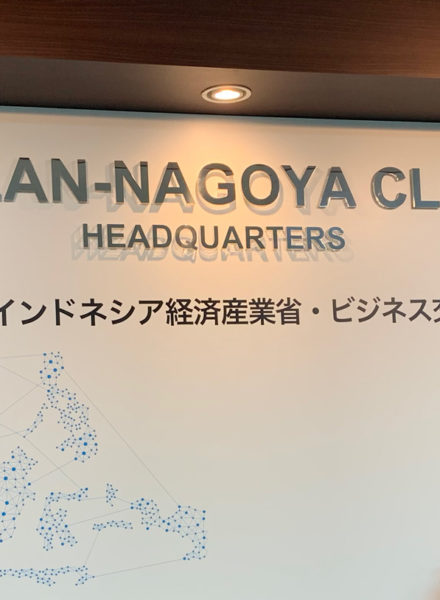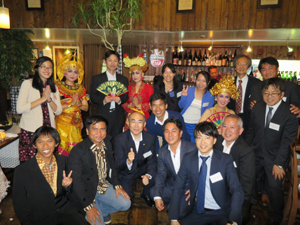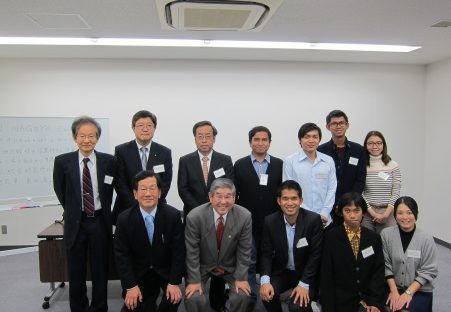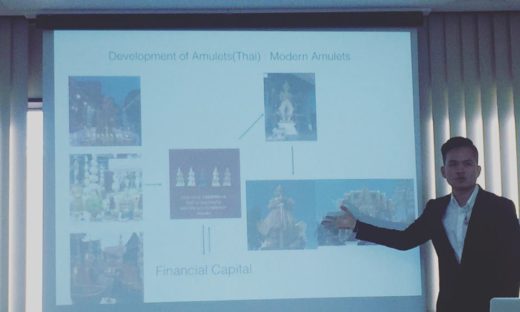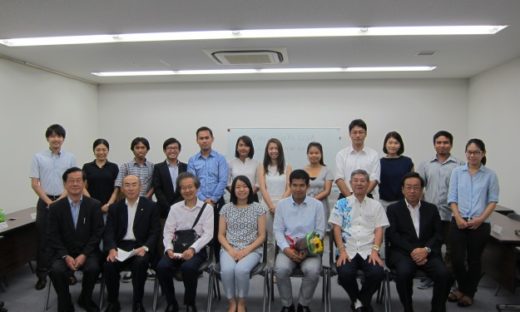第7回ミーティング報告書 2015年2月27日 (The 7th Meeting Report February 27, 2015)
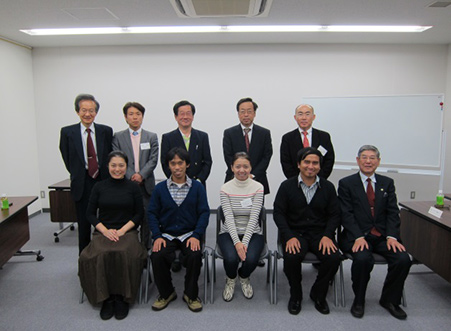
母国ミャンマーを語る
第六回は、熱田神宮への参拝でした。今年初めての研究会となります。第七回は、ミャンマーのMay Thiriさんに「母国ミャンマーを語る」と題して、お話しいただきました。私たち日本側スタッフも留学生の皆さんも手馴れてきたこと、また、島津さんのサポートもあり、素晴らしいプレゼントなりました。短時間でミャンマーの素顔を知ることができました。
正式名称は、ミャンマー連邦共和国(Republic of the Union of Myanmar)です。ミャンマーはマレー半島、インドシナ半島にありますが、日本人はミャンマーがタイの東側に位置するのか、西側に位置するのか、しっかり把握していない人も多くいます。ミャンマーはタイの西側に位置します。ミャンマーの国土は、日本の面積の約1.8倍で想像より大きな国です。また人口は5,141万人(2014年9月現在ミャンマー入国管理・人口省暫定発表)で、広い国土に日本の約半分の人口を擁します。生産年齢人口ピラミッドは、以下の図のような形をしています。「つり鐘型」から「つぼ型」へと急速に変化を遂げている日本と異なり、きれいなピラミッド型をしています。うらやましい形をしています。

Pyramid of working age population 生産年齢人口ピラミッド source:World Bank
一人当たりのGDPにおいては、ASEAN諸国の中でも、カンボジアと並び政治的背景により、最も立ち遅れていました。しかし、2011年の経済改革の断行により急速に発展することになりました。
中高年の日本人にはビルマという国名が懐かしいのですが、ビルマはイギリス統治下の名称であり、独立後、本来の国名ミャンマーとなりました。ミャンマーという名前は「川の北から来た」という意味です (ミィアウ・ミイアウン)。約80%がビルマ族ですが、135の少数民族に分かれ、それぞれの民族には強いアイデンティティがあるそうです。インドネシアと同様に多民族国家であり、統治には難しい課題がありそうです。
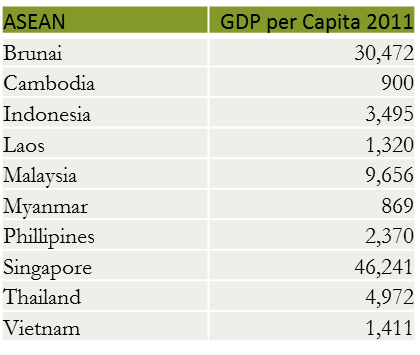
May Thiriさんの発表で、最も興味深かったのはミャンマー人と日本人の共通点でした。
共通点
1.対立を避ける(多くの人にとって「いいえ」と言うことは難しい)。
2.忍耐力に対する価値観
相違点
1.挨拶の言葉より微笑みや今の状況を聞くことが大切にされる
2.「ありがとう」は身内の人には使わない
ミャンマーに人は対立を好ましいこととは考えないようです。難しいことや嫌なことをお願いしても、「それはできません」とか「嫌だ」といった「いいえ」という返事をしないそうです。日本人と同様に、我慢強い。日本人も昔は、明確に「いいえ」と自己主張する人は少なかったのですが、最近は、白黒はっきりものをいう人が多くなりました。日本人がミャンマー人の価値観を知らずに、会話の中でミャンマーの人に「いいえ」と言われなかったことで、受け入れてもらったと早合点しないほうがよい、むしろ注意したほうがよいということでした。この面はデリケートでかつ重要な文化ですので、ミャンマーに進出する日本企業はこの点をしっかり理解しておくべきでしょう。
また、ミャンマーの人は言葉より、態度を重んじ、自分の置かれた状況を微笑みで返すのが上手です。微笑みの国ミャンマーといわれる所以です。また、家族にはありがとうと言わない。家族が困っているときに何かをしてあげるというのは「あたりまえ」だからということだそうです。また、ものをたくさん持っている人は尊敬されない、仕事をし過ぎる人も好感を持たれない。信仰に篤く自然体に生きる人々の姿が浮かび上がってきます。素朴で人間らしい生き方をしている人々が、経済発展の波によってどのように変わっていくかを考えたとき、複雑なものがあります。また、日系企業が日本式マネジメントを現地に根付かせようと、仕事中心の生活を強いていく可能性が高くなりますが、文化摩擦の潜在的要因となりますので、研究が必要です。
ミャンマーの文化と人々の暮らしをしっかりと理解したうえで、経済交流を深めていく必要性を再認識させられたといえます。
プレゼン後は、湯豆腐専門店に場所を移し、May Thirさんからさらにミャンマーの人々の詳細な生活ぶりをお聞きすることができました。聞けば聞くほど、日本人が失った謙虚な精神がまだ息づいているようで、懐かしい思いがしました。
Describing my home country Myanmar
This was the first study group this year. In the 7th session, Ms. May Thiri from Myanmar talked about her home country Myanmar. We were glad to be able to invite the International students with the support of Ms. Shimazu. We got to know the true face of Myanmar in a brief.
The official name of this country is Republic of the Union of Myanmar. Myanmar is located on the Malay Peninsula and the Indochina Peninsula, but many Japanese do not know exactly whether Myanmar is located on the eastern side or the western side of Thailand. Myanmar is located on the west side of Thailand. The land area of Myanmar is about 1.8 times of the area of Japan, which is larger than we imagined. It has a population of 51.41 million (as of September 2014, provisionally announced by the Ministry of Immigration and Population of Myanmar), and has about half the population of Japan in a large land area. The working-age population pyramid looks like the figure below. Unlike Japan, which is rapidly changing from a “bell-shaped” to a “pot-shaped”, it has a beautiful pyramid shape. It has an enviable shape.

Pyramid of working age population Pyramid of working age population source: World Bank In terms of GDP per capita, it was the lowest among ASEAN countries due to its political background, along with Cambodia. However, due to the implementation of economic reforms in 2011, it has developed rapidly.
The former name of Myanmar was Burma under British rule, and after independence, it became Myanmar. The name Myanmar means “come from the north of the river” (Miau Miaung). The population is about 80% Burmese, but they are divided into 135 ethnic minorities, and each ethnic group has a strong identity. Like Indonesia, it is a multi-ethnic country, and there are likely to be difficult challenges in governing it.

What was most interesting about May Thiri’s presentation was the commonalities between Burmese and Japanese.
Common point
1. 1. Avoid conflicts (it’s hard for Burmese to say “no”).
2. 2. Values for patience
Difference
1. 1. It is more important to smile and listen to the current situation than greetings
2. 2. “Thank you” is not common for relatives
Coordinator People in Myanmar do not seem to like conflict. Even if you ask for something difficult or unpleasant, they will not reply “no” such as “I can’t do it” or “I don’t like it”. Like Japanese, they are polite and patient. In the past, only a few Japanese people clearly asserted themselves as “no”, but recently, many people are more open and say black and white clearly. The fact that Japanese and Burmese did not say “no” have a slightly different meaning. Burmese tends to be very careful not to make mistake in making decision in the society or work place. This aspect is a delicate and important culture, so Japanese companies expanding into Myanmar should fully understand this point.
In addition, Burmese will respect other people with smile, they assume that smile is better than words. This is the reason why it is called Myanmar, the country of smiles. They don’t say thank you to their family. It is said that it is “natural” to do something when the family is in trouble. The Burmese are generally very patient and stoic in difficult circumstances.
It is common for people to restrain themselves from reacting to problems, saying “Shi-par-say-taw” (‘Let it be’). This relaxed attitude is somewhat attributed to the spiritual culture of the country. This modest, simple, and relaxed attitude is different from Japanese which are more likely to force a work-centered life in order to establish Japanese-style management. In this case, mutual understanding is important to avoid cultural friction.
After the presentation, we went to a Yudofu and was able to hear from May Thir about the detailed lifestyles of the people of Myanmar. The more I listened to it, the more humble spirit that the Japanese lost seemed to be still alive.
参加者:
<日本人メンバー>
小里氏、西氏、鈴木氏、大黒氏、倉科氏、松久氏(コーディネーター)、田中氏(スタッフ)
<留学生メンバー>
Mr.Indra Kesuma Nasution、Mr.Mardiansyah Mardis、Ms.MayThiri、島津氏(名古屋大学大学院コーディネーター)



